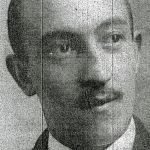RTS 10702 Shoeing Smith, Royal Army Service Corps
Died 6th January 1920, aged 29
Remembered on both Blakeney War Memorials
James was born 3rd July 1890 in Blakeney, the son of James Curry Smith, blacksmith and his wife Elizabeth Thompson. James was the eldest of their three children followed by Herbert Ernest, who also served in the Great War, and Sarah.
In 1911, James junior, aged 20, was a blacksmith living with his parents, siblings and grandfather, George Thompson, at 116 and 118 High Street. This was one house at that time, located at the top of Nurse’s or Smith’s Yard. The following year he married Agnes Maud Curson and their children were George, Herbert, Alec Kitchener and James Curry, all born between 1912 and 1919.
James enlisted at Great Yarmouth 21st April 1915, aged 25, giving his address as Binham. He declared that he had served in the Norfolk Volunteers. This time he was to serve with the Royal Field Artillery (RFA) as a Shoeing Smith No. 98451, with pay noted as 5/- a day. Within 3 months he was posted to France to serve with various Brigades until he returned to the UK, April 1917. A year later, April 1918, he was transferred to the Remount Depot of the Army Service Corps (ASC) at Ormskirk and given a new number, 10702. His records show two prefixes, firstly TS for Transport Special and then RTS which denotes Remounts Special. He spent a year at Ormskirk, the Depot taking charge of horses arriving at Liverpool, predominantly from South America, Australia, New Zealand and Ireland.
The spring following the Armistice, James was transferred to Class Z, Army Reserve on Demobilisation, 18th April 1919. Although there are no medical forms with his Service papers it is clear that he suffered from rheumatism. His demobilisation records that his rheumatism was wholly attributable to his war service and he left with a disability pension for 26 weeks. Rheumatism had blighted his service and was ultimately the cause of his death, for which there was an inquiry brought by the Holt Branch of the Discharged Sailors and Soldiers’ Federation against the Walsingham War Pensions Committee. Seemingly James had first sought their help in June and then, with the help of his local representative Mr. C. Temple-Lines, repeatedly over the next six months only to die 20 minutes before an ambulance finally arrived to take him to the Norfolk and Norwich Hospital. This caused a great deal of public feeling and it was felt that there had been gross neglect on the part of some one. The case needed to be ventilated so that the public might come to the right conclusion.
Essentially the case hinged on whether James was a soldier or a civilian, even though he was still a Class Z reserve. Blame was passed back and forth with the secretary of the War Pensions Committee, Sam Peel, insisting James was a civilian, that Dr Kay could and should have sent him to hospital and that he, Sam Peel, was never informed of the seriousness of James’s condition until late December. It was a sorry saga of considerable misunderstanding, missed opportunities and letters that, seemingly, Sam Peel never received! The Norfolk Chronicle reported in full on all three meetings, 23rd and 30th January and 13th February 1920, and gave the finding of the Chairman of the War Pensions Committee as follows; “that while there had been apparently some delay in this case they were all of the opinion that their secretary had done his best.”
James Smith has not been recognised by the Commonwealth War Graves Commission and to this day he lies in an unmarked grave in St Nicholas churchyard.

